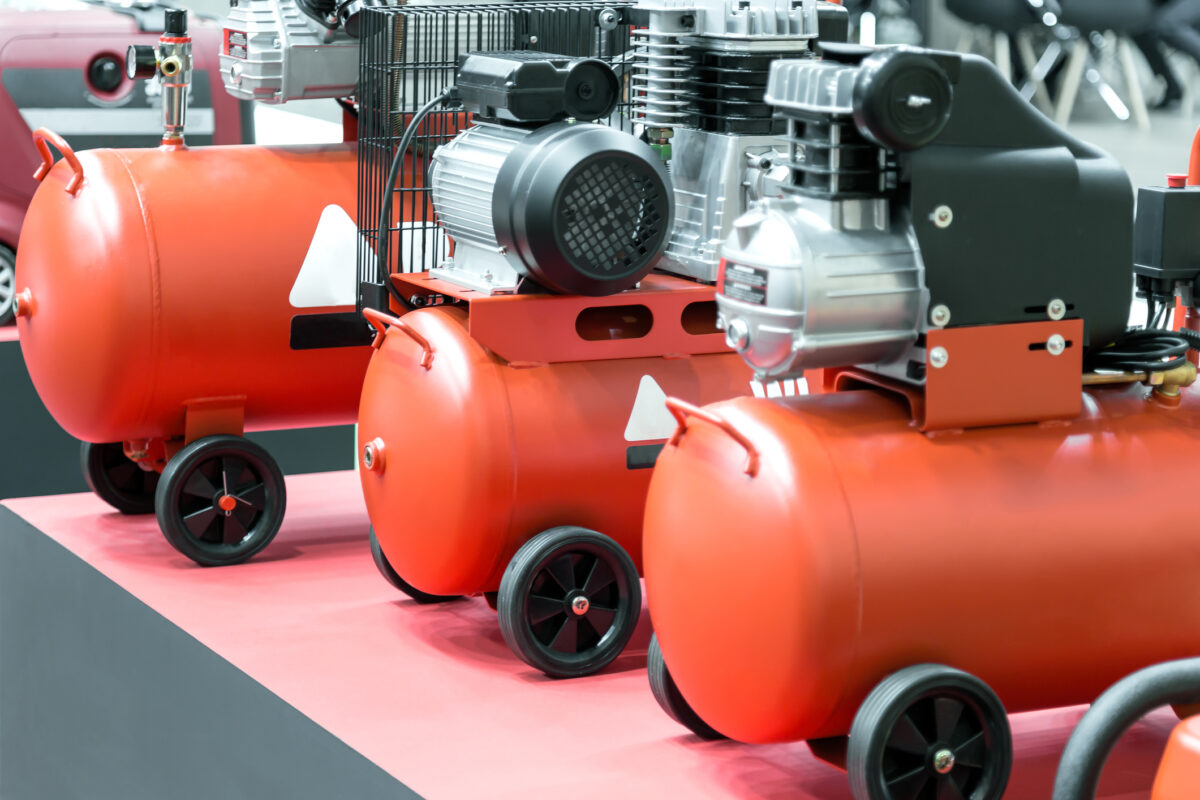Table of Contents
Many professionals find themselves needing more compressed air than a single tank provides, especially when operating pneumatic tools such as a spray gun or HVLP gun. There may be a higher demand for air volume or you may desire a larger duty cycle. The simplest way to meet this need might be to invest in a larger, more powerful compressor with a large tank. However, sometimes, two smaller compressors make more sense than one larger compressor.
Why? Smaller compressors can be easier to handle and transport, plus if one breaks down, you aren’t left without an air supply. Today, we’ll tackle how you can effectively connect two air compressors. In doing so, you will mimic the effects of a larger compressor while retaining the benefits of smaller components. By the end of this article, we’re confident you’ll have a clear understanding of how to approach this task, including its benefits, potential pitfalls, and the best practices to observe.
The Short Answer: The basic process involves setting up a single pressure switch system linking both compressors, using a check valve to prevent air backflow, and using suitable hoses or pipes. This configuration allows you to harness the combined power of two smaller compressors, giving you an output that rivals or even surpasses one larger air tank.
The Basics: What You Need to Connect Two Air Compressors
Before we delve into the practical side of connecting two air compressors, it’s essential to understand the components involved. Here, we’ll break down the key elements you’ll need to execute this task effectively.
The Compressors
Firstly, you’ll need two compressors – these could be gallon compressors or HP compressors, depending on what suits your needs best. The capacity of your compressor, measured in gallons or horsepower, will dictate how much pressurized air your system can produce.
The Air Hose
The air hose connects the two compressors, facilitating air transmission from one to the other. It is essential to remember that the hose you use is rated for the maximum output pressure that your compressors can deliver.
The Valves
In this setting, you’ll also need a ball valve and a check valve. The ball valve enables control over the airflow between the two compressors, granting an option to stop it when needed. The check valve ensures unobstructed air movement by preventing backflow from one compressor into the other.
The Pressure Switch
The pressure switch is the primary controller in this setup. It assesses the pressure within the compressor tanks and, based on these readings, toggles the motor on and off. Both compressors’ pressure switches must have similar pressure points for activation and deactivation.
The Pressure
Lastly, the pressure rating and output pressure are two significant aspects to consider. The pressure rating reveals the highest pressure the tank can safely manage, while the adjustable output pressure, set through the compressor’s pressure regulator, determines the pressure level of the released air.
The Process: Step-By-Step Guide on Connecting Two Air Compressors
Armed with a firm understanding of the key components, we can now focus on the practical steps to link two air compressors effectively. This may seem like a demanding task, but with patience and careful execution, it can be done efficiently.
Step 1 – Setup
Begin by placing your two compressors side by side, ensuring they are stable and secure. Connect the first compressor (this will be the lead compressor) to a power outlet. The lead compressor will control the pressure shared with the second – so it must be capable of building pressure fast.
Step 2 – Connect the Air Hose
Once your compressors are positioned correctly, connect your air hose to both compressors. Attach one end of the air line to the regulated air outlet on the first compressor. If you need a longer air hose but don’t have one on hand, you can connect multiple air hoses together. Most hoses are equipped with either a threaded attachment or a quick-release coupling. A male thread connects into a female thread, while a male quick-release inserts into a female quick-release, which might require a coupling to join lines.
Step 3 – Install the Check Valve & Ball Valve
Now, position the check valve at a strategic point along the air hose, ensuring it is facing the right direction to facilitate the flow of air. Then insert the ball valve. The ball valve will act as a fail-safe that will allow you to isolate one of the compressors if needed.
Step 4 – Connect Second Compressor
Connect the opposite end of the air hose to the intake of the second compressor. The second compressor should not be connected to a power source to avoid doubling the amount of air drawn into the system.
Step 5 – Adjust Pressure Switches
As we mentioned before, the pressure switches on both compressors must activate and deactivate at similar pressure points. If the first compressor turns on at a lower pressure than the 2nd compressor you will run into issues. Therefore, you may need to adjust the settings on one or both pressure switches to achieve this synchronization.
Step 6 – Test Your System
Now it’s time to test your new setup. Switch on the first compressor and allow it to build up pressure before you start the second compressor. Monitor both compressors to ensure they are working properly and not overloading.
Pros and Cons: Understanding the Benefits and Drawbacks
Now that we’ve established the steps of connecting two air compressors, it’s equally important to weigh the benefits and potential challenges of this type of setup. This will help you to decide whether this approach is right for you.
Benefits of Combining Two Air Compressors
- Increased Air Volume: By pairing two compressors, you significantly increase the total volume of air. This translates into a longer duty cycle than a bigger compressor, meaning you can operate your air tools for more extended periods without overloading your compressors.
- Backup Option: As we mentioned earlier, having two compressors means if one breaks down or requires maintenance, you still have one functioning compressor to keep your operations going.
Drawbacks of Combining Two Air Compressors
- Complex Setup: Doubling up compressors makes for a more complicated setup, requiring extra careful attention to ensure everything works smoothly and safely (i.e. synchronizing both pressure switches).
- Space Consideration: While small compressors offer versatility, setting up two can require more space to fit the extra tank than a singular large compressor would.
How Advanced Air & Vacuum Can Help
Remember that when it comes to handling air compressors, you don’t have to do it alone. Advanced Air & Vacuum is not just a supplier, we’re a partner. We offer expertise to help find the best solution for your specific air compressor needs. If you need high-quality compressors, compressor maintenance, or air system repair services, reach out to Advanced Air & Vacuum.Your business deserves the expertise and care only we can provide – contact us today!

